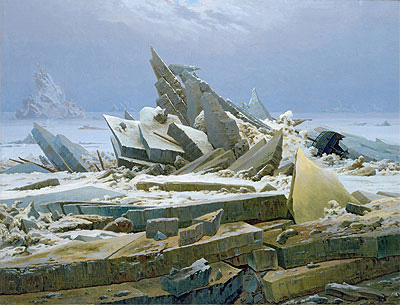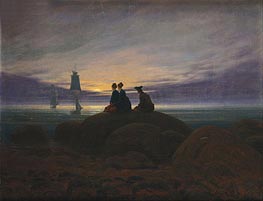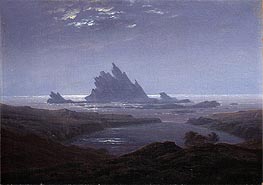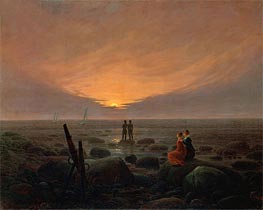The Polar Sea (The Sea of Ice), c.1823/24 Caspar David Friedrich (1774-1840)
Location: Hamburger Kunsthalle Hamburg GermanyOriginal Size: 96.7 x 126.9 cm
Own a museum-quality reproduction of The Polar Sea (The Sea of Ice) by Caspar David Friedrich (c.1823/24), exclusively hand-painted in oils on linen canvas by European artists with academic training. Each masterpiece is created with meticulous craftsmanship, capturing the exceptional quality and authentic brushwork of the original painting.


Recreating Caspar David Friedrich: A Video Journey into Museum-Quality Reproductions by TOPofART
Video showcasing the process of hand-painting a Caspar David Friedrich masterpiece with the utmost precision and care for detail.
Oil Painting Reproduction
If you want a different size than the offered
Description
Painted by European Аrtists with Academic Education
Museum Quality
+ 4 cm (1.6") Margins for Stretching
Creation Time: 8-9 Weeks
Creation Process
We create our paintings with museum quality and covering the highest academic standards. Once we get your order, it will be entirely hand-painted with oil on canvas. All the materials we use are the highest level, being totally artist graded painting materials and linen canvas.
We will add 1.6" (4 cm) additional blank canvas all over the painting for stretching.
High quality and detailing in every inch are time consuming. The reproduction of Caspar David Friedrich also needs time to dry in order to be completely ready for shipping, as this is crucial to not be damaged during transportation.
Based on the size, level of detail and complexity we need 8-9 weeks to complete the process.
In case the delivery date needs to be extended in time, or we are overloaded with requests, there will be an email sent to you sharing the new timelines of production and delivery.
TOPofART wants to remind you to keep patient, in order to get you the highest quality, being our mission to fulfill your expectations.
We not stretch and frame our oil paintings due to several reasons:
Painting reproduction is a high quality expensive product, which we cannot risk to damage by sending it being stretched.
Also, there are postal restrictions, regarding the size of the shipment.
Additionally, due to the dimensions of the stretched canvas, the shipment price may exceed the price of the product itself.
You can stretch and frame your painting in your local frame-shop.
Delivery
Once the painting The Polar Sea (The Sea of Ice) is ready and dry, it will be shipped to your delivery address. The canvas will be rolled-up in a secure postal tube.
We offer free shipping as well as paid express transportation services.
After adding your artwork to the shopping cart, you will be able to check the delivery price using the Estimate Shipping and Tax tool.
Museum Quality
The paintings we create are only of museum quality. Our academy graduated artists will never allow a compromise in the quality and detail of the ordered painting. TOPofART do not work, and will never allow ourselves to work with low quality studios from the Far East. We are based in Europe, and quality is our highest priority.
Additional Information
The painting also draws on the exploration zeitgeist of the time. The early 19th century was a period when polar expeditions were headline news, capturing the public’s imagination. Friedrich, ever the Romantic, seized on this spirit of adventure - and the accompanying peril - to create a kind of visual poem about human fragility. Edward William Parry’s expeditions to the North Polar region are mentioned as a possible source of inspiration, grounding the painting in the real, perilous expeditions of the time, which often ended in disaster. Here, Friedrich isn't just painting ice; he's painting the existential fear of the unknown and the relentless power of nature.
One of the most striking pieces of information is the painting’s earlier title: “Die gescheiterte Hoffnung” or "The Failed Hope." This adds an almost narrative dimension to the work. The ship buried under the ice becomes more than just a casualty of a frozen landscape; it’s a symbol of human ambition dashed against the rocks (or, in this case, the ice floes) of reality. This isn't just a wreck - it’s a metaphor for crushed dreams, failed endeavors, and perhaps, on a larger scale, a critique of human arrogance. The choice to abandon this title might seem curious, but it reveals Friedrich’s subtlety: rather than lock viewers into one interpretation, he allows the work to transcend into something more universal.
There's also an undeniable religious undercurrent. The interpretation suggesting hope for eternal life after death, as evidenced by the clearing sky, invites viewers to see the painting as more than just a depiction of destruction. In true Romantic fashion, Friedrich seems to be telling us that even in the most desolate of places, there is always a flicker of hope - a belief in transcendence, perhaps even salvation.
Friedrich’s technique of scaling up the ice floes, making them larger than life, shifts the painting from being a literal representation to a more symbolic one. This is not an exercise in documentary realism. The ice doesn’t just appear daunting; it’s apocalyptic. The jagged, chaotic composition adds to the sense of helplessness - man versus nature, with nature holding all the cards.
The cold, austere palette of blues, whites, and grays deepens the emotional impact. It’s like the very air has frozen, trapping not just the ship but the viewer in this endless, icy void. The colors reinforce the themes of desolation and abandonment.
Beyond its religious interpretations, the painting has also been read through political lenses. Friedrich’s time was one of upheaval and political change. This painting, with its themes of destruction and dashed hopes, can be viewed as a reflection of the uncertain, often perilous journey of mankind, whether on an expedition or in the political arena. The shipwreck could symbolize the fragility of human endeavors - be they political, philosophical, or exploratory.
Friedrich’s "The Sea of Ice" is much more than a shipwreck scene or a frozen landscape. This work touches on human ambition, existential dread, and spiritual hope, all wrapped in the veil of Romanticism. It’s a painting of destruction, but one that - in typical Friedrich fashion - leaves a window open for transcendence, however faint. The ship may be wrecked, but there is something about that clearing sky that refuses to let the viewer sink into total despair.

The Moon Rising over the Sea c.1822
$1056
$64.85
Caspar David Friedrich
Original Size:55 x 71 cm
Gemaldegalerie, Berlin, Germany

Rocky Reef on the Sea Shore c.1824
$578
$55.76
Caspar David Friedrich
Original Size:22 x 31 cm
Staatliche Kunsthalle, Karlsruhe, Germany

Moonrise over the Sea 1821
$1351
$67.00
Caspar David Friedrich
Original Size:135 x 170 cm
The State Hermitage Museum, St. Petersburg, Russia

Village Landscape in Morning Light (The Lone Tree) 1822
$1439
$66.38
Caspar David Friedrich
Original Size:55 x 71 cm
Gemaldegalerie, Berlin, Germany

Rocky Ravine c.1822/23
$1632
$66.38
Caspar David Friedrich
Original Size:94 x 74 cm
Kunsthistorisches Museum, Vienna, Austria